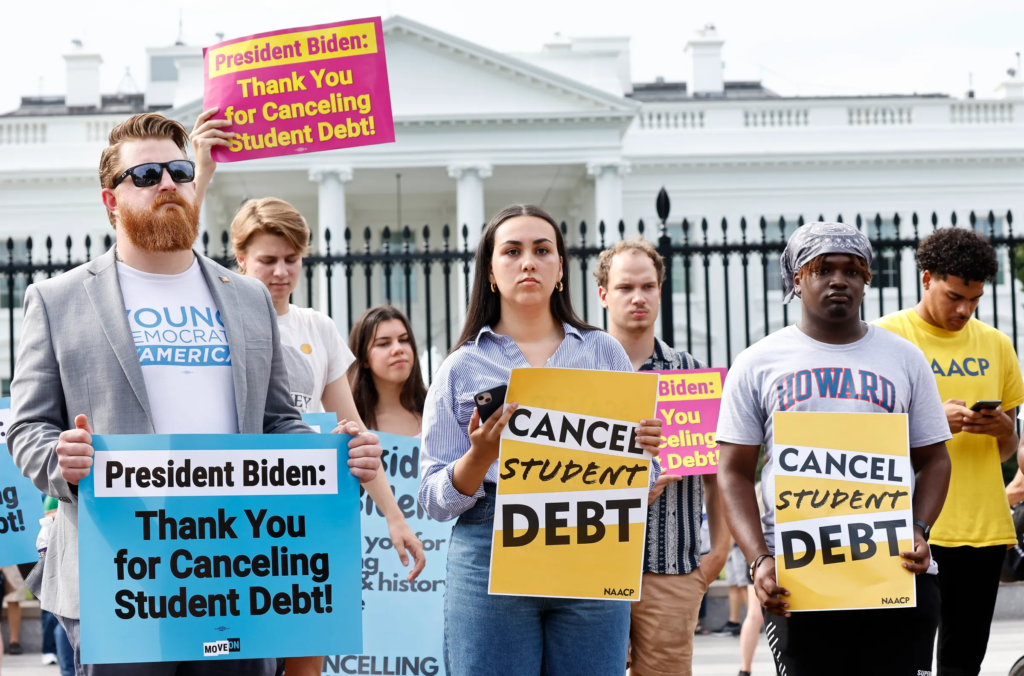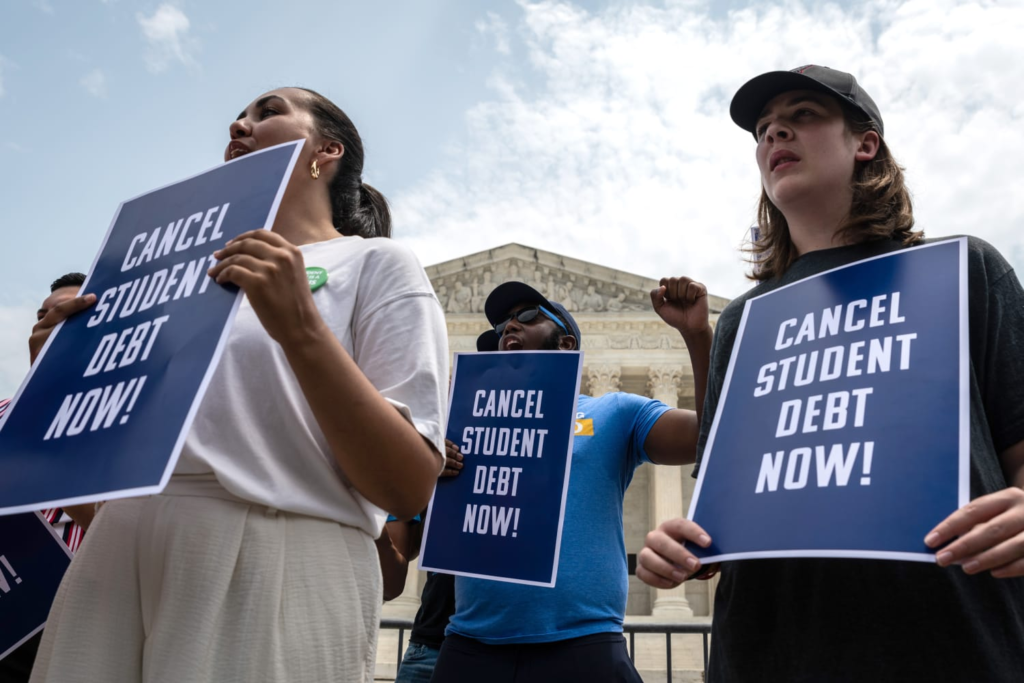The student loan forgiveness debate has become one of the most polarizing issues in American politics and economics. With over 43 million Americans carrying student debt that totals more than $1.6 trillion, questions about how to address this burden have taken center stage. Supporters argue that forgiving loans would provide relief, boost consumer spending, and promote social mobility. Critics counter that such policies are costly, unfair to those who already paid their debts, and may fuel inflation.
Understanding this debate requires looking at not just the financial numbers, but also the economic, political, and social consequences of widespread loan forgiveness.
A Brief History of Student Loan Debt in America
Student loans became a major part of higher education financing in the second half of the 20th century. The federal government introduced loan programs to expand access to college, aiming to help students from middle- and low-income families afford higher education. Over time, however, rising tuition costs and stagnant wages created a system where debt became the norm for graduates.
Today, the average borrower owes around $30,000, though balances can be much higher for those pursuing advanced degrees. Unlike most other types of debt, student loans are difficult to discharge in bankruptcy, making repayment a long-term obligation for many.

Why the Student Loan Forgiveness Debate Matters
The debate is not just about dollars and cents. It also reflects deeper questions about fairness, opportunity, and the role of government in supporting education and the economy.
- Should education be seen as a public good worth subsidizing?
- Is it fair to forgive loans for some when others have already sacrificed to pay theirs off?
- How will forgiveness affect taxpayers and federal budgets?
- Could it encourage future borrowing and rising tuition?
These questions fuel the passion on both sides of the argument.
Arguments in Favor of Student Loan Forgiveness
Boosting Consumer Spending
Supporters argue that debt forgiveness would free up income that borrowers could spend on housing, cars, small businesses, and other consumer goods. This could stimulate economic growth by increasing demand.
Reducing Wealth Gaps
Student loan debt disproportionately affects younger generations, women, and borrowers of color. Forgiveness could help reduce wealth inequality by providing targeted relief to groups most burdened.
Encouraging Homeownership and Family Formation
Many borrowers delay buying homes, starting families, or saving for retirement due to loan payments. Loan forgiveness could remove these barriers, giving younger generations a stronger financial foundation.
Improving Mental Health and Productivity
Debt stress takes a toll on mental health. Supporters claim forgiveness would reduce anxiety, allowing people to focus on careers and contributions to the economy.
Education as a Public Investment
Forgiveness advocates view education as a public good, like roads or healthcare. In this view, government support for education benefits the entire economy by creating a more skilled workforce.
Arguments Against Student Loan Forgiveness
Cost to Taxpayers
Opponents argue forgiveness simply transfers debt from borrowers to taxpayers. Estimates suggest broad cancellation could cost hundreds of billions of dollars, increasing the national deficit.
Unfairness to Past Borrowers
Critics say forgiveness is unfair to those who already worked hard or made sacrifices to pay off their loans. It also excludes people who chose not to attend college to avoid debt.
Inflation Concerns
Some economists worry that freeing up consumer income could add to inflation, especially in an economy already dealing with rising prices.
Tuition Inflation
There is concern that forgiving current debt without reforming the system could encourage universities to keep raising tuition, expecting future forgiveness to shield students from the cost.
Limited Targeting
Critics also argue that forgiveness is a blunt instrument. Many high earners, such as doctors and lawyers, hold large amounts of student debt but have the potential to repay it. Forgiving their loans, opponents say, would unfairly benefit the wealthy.

The Economic Impact of Student Loan Forgiveness
The real economic impact depends on how forgiveness is designed.
- Partial forgiveness (such as canceling $10,000 per borrower) would provide relief without eliminating all debt. It would likely have a moderate economic boost, especially for lower-income borrowers.
- Full cancellation could provide massive relief but at a much higher cost to taxpayers.
- Income-based targeting would direct relief to those most in need, such as borrowers with low incomes or those in public service jobs.
Economists note that forgiveness might increase consumer spending in the short term but could raise concerns about long-term fiscal sustainability.
Alternatives to Loan Forgiveness
Some suggest reforms instead of or alongside forgiveness:
- Income-driven repayment plans that cap payments based on earnings.
- Lower interest rates on federal loans to make repayment easier.
- Expanded Pell Grants or free community college to reduce future borrowing.
- Bankruptcy reform allowing student loans to be discharged more easily in extreme cases.
- Targeted forgiveness for public servants, teachers, or low-income borrowers.
These approaches aim to address both the burden of existing debt and the root causes of rising education costs.
Political Dimensions of the Debate
The student loan forgiveness debate is deeply political. Progressive leaders advocate broad cancellation, framing it as an issue of fairness and opportunity. Moderates and conservatives caution against the economic and budgetary consequences.
Court rulings have also shaped the debate, striking down or limiting executive actions on loan forgiveness, raising questions about whether Congress should take the lead.
With elections on the horizon, student debt relief remains a hot-button issue, especially for younger voters who are more likely to carry loans.
The Human Side of the Debate
Beyond numbers and policy, student loan forgiveness is about real people. Millions of Americans have delayed milestones like homeownership, marriage, or retirement due to debt. For some, a few thousand dollars of relief could mean the difference between stability and financial struggle.
Stories of nurses, teachers, or first-generation college graduates illustrate the emotional weight of this issue. For them, forgiveness is not just an economic policy—it is a chance at a fresh start.
Looking Ahead: The Future of Student Loan Forgiveness
The debate will not end anytime soon. Policymakers continue to explore compromise solutions that balance relief with fiscal responsibility. The outcome will likely depend on political dynamics, economic conditions, and the voices of millions of borrowers advocating for change.
What is clear is that the student loan system itself requires reform. Without addressing the underlying causes of rising tuition and reliance on debt, forgiveness—whether partial or total—will be a temporary fix rather than a long-term solution.
Conclusion
The student loan forgiveness debate captures the tension between economic pragmatism and social justice. Supporters see it as a pathway to opportunity, financial relief, and a more equitable economy. Critics view it as costly, unfair, and potentially harmful to the nation’s fiscal health.
Whatever side one takes, the issue forces Americans to grapple with fundamental questions: How much should the government invest in education? What level of personal responsibility should borrowers bear? And how do we balance fairness with economic growth?
In the end, the resolution of this debate will shape not just the financial future of millions of borrowers, but also the broader direction of the U.S. economy.
Do Follow USA Glory On Instagram
Read Next – State vs Federal Power Struggles in Policymaking






